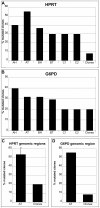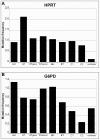Evidence of genetic instability in tumors and normal nearby tissues
- PMID: 20186333
- PMCID: PMC2826410
- DOI: 10.1371/journal.pone.0009343
Evidence of genetic instability in tumors and normal nearby tissues
Abstract
Background: Comprehensive analyses have recently been performed on many human cancer tissues, leading to the identification of a number of mutated genes but providing no information on the variety of mutations present in each of them. This information is of interest to understand the possible origin of gene mutations that cause tumors.
Methodology/principal findings: We have analyzed the sequence heterogeneity of the transcripts of the human HPRT and G6PD single copy genes that are not considered tumor markers. Analyses have been performed on different colon cancers and on the nearby histologically normal tissues of two male patients. Several copies of each cDNA, which were produced by cloning the RT-PCR-amplified fragments of the specific mRNA, have been sequenced. Similar analyses have been performed on blood samples of two ostensibly healthy males as reference controls. The sequence heterogeneity of the HPRT and G6PD genes was also determined on DNA from tumor tissues. The employed analytical approach revealed the presence of low-frequency mutations not detectable by other procedures. The results show that genetic heterogeneity is detectable in HPRT and G6PD transcripts in both tumors and nearby healthy tissues of the two studied colon tumors. Similar frequencies of mutations are observed in patient genomic DNA, indicating that mutations have a somatic origin. HPRT transcripts show genetic heterogeneity also in healthy individuals, in agreement with previous results on human T-cells, while G6PD transcript heterogeneity is a characteristic of the patient tissues. Interestingly, data on TP53 show little, if any, heterogeneity in the same tissues.
Conclusions/significance: These findings show that genetic heterogeneity is a peculiarity not only of cancer cells but also of the normal tissue where a tumor arises.
Conflict of interest statement
Figures



Similar articles
-
Mutational spectra at the hypoxanthine-guanine phosphoribosyltransferase (HPRT) locus in T-lymphocytes of nonsmoking and smoking lung cancer patients.Mutat Res. 2000 Jun 22;468(1):45-61. doi: 10.1016/s1383-5718(00)00039-5. Mutat Res. 2000. PMID: 10863157
-
p53 tumor suppressor gene status and the degree of genomic instability in sporadic colorectal cancers.J Natl Cancer Inst. 1996 Nov 20;88(22):1665-70. doi: 10.1093/jnci/88.22.1665. J Natl Cancer Inst. 1996. PMID: 8931611
-
P53 mutations in colorectal cancer assessed in both genomic DNA and cDNA as compared to the presence of p53 LOH.Int J Oncol. 2002 Aug;21(2):409-15. Int J Oncol. 2002. PMID: 12118339
-
Involvement of the multiple tumor suppressor genes and 12-lipoxygenase in human prostate cancer. Therapeutic implications.Adv Exp Med Biol. 1997;407:41-53. doi: 10.1007/978-1-4899-1813-0_7. Adv Exp Med Biol. 1997. PMID: 9321930 Review.
-
The TP53 colorectal cancer international collaborative study on the prognostic and predictive significance of p53 mutation: influence of tumor site, type of mutation, and adjuvant treatment.J Clin Oncol. 2005 Oct 20;23(30):7518-28. doi: 10.1200/JCO.2005.00.471. Epub 2005 Sep 19. J Clin Oncol. 2005. PMID: 16172461 Review.
References
-
- Coleman WB, Tsongalis GJ. Multiple mechanisms account for genomic instability and molecular mutation in neoplastic transformation. Clin Chem. 1995;41:644–57. - PubMed
-
- Loeb LA. A mutator phenotype in cancer. Cancer Res. 2001;61:3230–9. - PubMed
-
- Loeb KR, Loeb LA. Significance of multiple mutations in cancer. Carcinogenesis. 2000;21:379–85. - PubMed
-
- Jackson AL, Loeb LA. On the origin of multiple mutations in human cancers. Semin Cancer Biol. 1998;8:421–9. - PubMed
Publication types
MeSH terms
Substances
LinkOut - more resources
Full Text Sources
Medical
Research Materials
Miscellaneous

